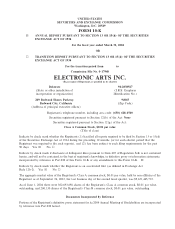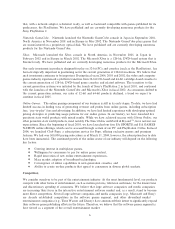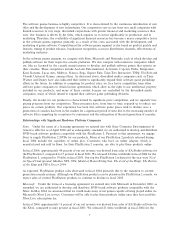Electronic Arts 2004 Annual Report Download - page 21
Download and view the complete annual report
Please find page 21 of the 2004 Electronic Arts annual report below. You can navigate through the pages in the report by either clicking on the pages listed below, or by using the keyword search tool below to find specific information within the annual report.that, with a network adaptor, is Internet ready, as well as backward compatible with games published for its
predecessor, the PlayStation. We have published and are currently developing numerous products for the
Sony PlayStation 2.
Nintendo GameCube. Nintendo launched the Nintendo GameCube console in Japan in September 2001,
North America in November 2001 and in Europe in May 2002. The Nintendo GameCube plays games that
are manufactured on a proprietary optical disk. We have published and are currently developing numerous
products for the Nintendo GameCube.
Xbox. Microsoft launched the Xbox console in North America in November 2001, in Japan in
February 2002 and in Europe in March 2002. The Microsoft Xbox is a 128-bit, DVD-based system that is
Internet ready. We have published and are currently developing numerous products for the Microsoft Xbox.
Our early investment in products designed for play on 32-bit PCs and consoles (such as the PlayStation), has
been strategically important in positioning us for the current generation of 128-bit machines. We believe that
such investment continues to be important. During Ñscal years 2004, 2003 and 2002, the video and computer
games industry experienced a platform transition from 32-bit CD-based and 64-bit cartridge-based consoles to
the current generation of 128-bit, DVD-based game consoles and related software. The transition to the
current generation systems was initiated by the launch of Sony's PlayStation 2 in Ñscal 2001, and continued
with the launches of the Nintendo GameCube and Microsoft's Xbox in Ñscal 2002. As consumers shifted to
the current generation systems, our sales of 32-bit and 64-bit products declined, a trend we expect to
continue in Ñscal 2005.
Online Games. The online gaming component of our business is still in its early stages. To date, we have had
limited success in Ñnding ways of generating revenue and proÑts from online games, including subscription
fees, ""pay-to-play'' fees and advertising. In addition, we have had limited experience with developing optimal
pricing strategies or predicting usage patterns for our online games. In our history, we have launched Ñve
persistent state world products with mixed results. While we have achieved success with Ultima Online, our
other persistent state world products, most notably The Sims Online and Earth & Beyond
TM
, have not met our
expectations. Since the beginning of Ñscal 2003, we have launched our free EA SPORTS and EA GAMES
NATION online oÅerings, which can be accessed through certain of our PC and PlayStation 2 titles. In Ñscal
2004, we launched Club Pogo, a subscription service for Pogo, oÅering exclusive games and premium
features. We had over 300,000 paying subscribers as of March 31, 2004, however, the subscription fees to date
have been immaterial. The continued growth of the online sector of our industry will depend on the following
key factors:
䡵Growing interest in multiplayer games,
䡵Willingness by consumers to pay for online game content,
䡵Rapid innovation of new online entertainment experiences,
䡵Mass market adoption of broadband technologies,
䡵Convergence of online capabilities in next-generation consoles, and
䡵Ability to create on-line products that appeal to consumers in diverse global markets.
Competition
We consider ourselves to be part of the entertainment industry. At the most fundamental level, our products
compete with other forms of entertainment, such as motion pictures, television and music, for the leisure time
and discretionary spending of consumers. We believe that large software companies and media companies
are increasing their focus in the interactive entertainment software market and, as a result, stand to become
more direct competitors. Several large software companies and media companies (e.g., Microsoft and Sony)
are already established competitors in the software games segment, and other diversiÑed media/
entertainment companies (e.g., Time Warner and Disney) have announced their intent to signiÑcantly expand
their software game publishing eÅorts in the future. Therefore, we believe that the software games segment is
best viewed as a segment of the overall entertainment market.
6
























